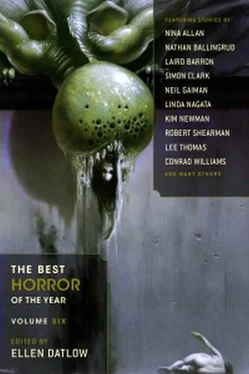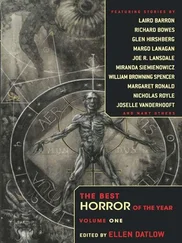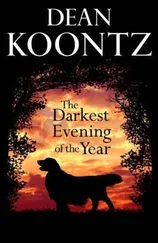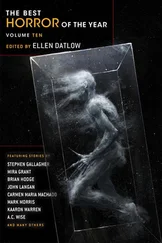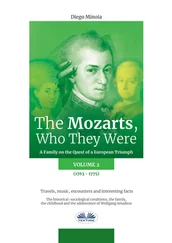It appears to have been a symbol with which Vivian Crane was obsessed as well, since, following her disappearance, numerous versions of it were said to have been found scratched on the walls throughout her house. This evidence, combined with the temporal shifts reported by Ms. Crane and all three of the former residents interviewed, originally led this author to theorize that this particular “haunting” is an occurrence on the order of “freak” weather events such as rains of frogs, sudden tornadoes, and so on. In other words, not ghosts at all, but an anomaly in the very fabric of time and space, burst into existence at some stage in the last few years. And the Ouroboros symbols suggest some sort of intelligence lurking behind this anomaly, something perhaps even more fearsome than the ghosts that populate the rest of this volume.
— Ghosts and Ghouls of the New American South , by Roger St. Lindsay, Random House, 2010
I’ve been reading Roger St. Lindsay’s account of our local haunting, and reckless and inaccurate as his speculations appear to me (not to mention entirely ignorant of the laws of physics, and this apparent even to myself who knows as little about the topic as anyone), his method is not entirely one of madness. His history of the house is more or less corroborated, although his theories do border on the ludicrous. By the way, an alert reader recently forwarded to me the details, available only with a “pro”-level subscription, of an IMDB page regarding the documentary The Disappearance of Vivian Crane . Currently Vincent Llewellyn, who made his name with the Poltergeist Rising series of fictional “found footage” horror movies, is attached to the project. Apparently, however, production on the Crane documentary was halted due to legal concerns.
— Perry “Pear Tree” Parry, blog post at
Under the Pear Tree , August 12, 2010
Vivian wakes.
It is not a night like any other night. At first she cannot be certain why this is the case, and then she realizes: it’s because of the silence.
This is a terrible thing. Like the silence of children up to no good, except this silence is sinister, not mischievous. She reaches to touch Chris and of course he is not beside her. She does this almost every night, but this time it reminds her of that other night. The last night. She had not been immediately concerned — why should she have been? — even though it wasn’t like him to be up in the middle of the night, but then Chris had not seemed much like himself for some time. That night, she reached for the lamp and in the little pool of light she found her robe. She peeked into the guest room and at the sofa and Chris was nowhere. She went through the house looking for him, still not concerned, because none of it seemed real although she was certain it was not a dream.
Back up the stairs and down them again. It was here she began to call his name, here she started to get really worried. She wanted to be angry, because angry was better than worried, and she thought that she would be angry later, after finding him, angry at him for frightening her and happy for the chance to be angry because it would mean nothing was really wrong.
Later the questions would come, disbelieving: how could she have slept through the shotgun blast? Had she been drinking? Did she take drugs? Sleeping pills? Did she and Chris have a fight beforehand? They needn’t have blamed her; she blamed herself. How could you not have known, how could you not have done something, how could you, how could you?
She had not been the one who found him propped against the back fence, his head ruined; a neighbor phoned the police shortly after it happened, reporting a gunshot, but this could not be possible, for she walked up and down the stairs and from room to room for hours, searching for him, long before she stumbled into a backyard awash in spinning lights and the sound of police radios and a cacophony of panic.
Some nights, the best nights, the police never arrived. On those nights, she searched until she, Vivian Crane née Collins — born Vancouver, Washington, June 10, 1971, raised in Seattle, the shy bookish only child of a single mother (father present only following occasional bursts of paternal guilt) — ceased to exist, or became a ghost, if that was indeed how one did become a ghost; she simply searched and searched the rooms, and the stairs, and the hallways again and again until she no longer remembered who she was or what she was looking for, and sometimes she woke and still could not remember for long moments where she belonged.
Driving Felicity to the airport in Atlanta at the end of her visit almost saved her. Almost. She remembered thinking that — remembered the hard and beautiful reality of Interstate 285 with its multiple lanes of frantic traffic, the billboards and the chain restaurants and the warehouses and the mundanity of it all. At Hartsfield, the busiest airport in the world, she stood in line at the check-in counter with Felicity and thought about sleek planes bearing her away to someplace, any other place, a place that was safe and faraway, and then she saw Felicity through the security gate. Afterward, she sat in the atrium in the main terminal for a while and chewed on a pesto chicken panini from the Atlanta Bread Company and thought about what to do next.
In the end, it was all too overwhelming: where would I go how would I explain to people what would happen to me my job my life my belongings I don’t know any other way .
And she got in her car and she drove back home again.
Chris’s death had branded her as much as the Ouroboros symbol ever would.
So now she wakes to the silence of infinity. She has a singular thought, to leave the house, and it is so strong she wonders that she has not thought it before. She has been sleeping in a T-shirt and a pair of yoga pants (she used to take yoga, long ago when she also used to be a real person); to change, to even find her shoes would delay her disastrously, and her feet hit the floor with a thump and she is running down the stairs; she half expects the corridor to stretch out forever before her like a horror movie or a dream but the corridor is normal and the door springs open to her touch and outside the stars are reeling and she gasps lungfuls of air that are not house-air and she is free; it is so easy, she need only not go back inside again. She doesn’t have her keys (no time) so she cannot take the car, but she can run now, up the street, she can run forever if she has to, because even the simple act of breathing and running is an act of living and not one of extinction.
But here is nothing but silence. A dead, dark street, familiar houses blank and empty, no sound of traffic from the busy street a block away. No dogs barking, no sirens, nothing.
She will run back into the house and reset it; this time it will work.
Back inside the house. Deep breaths on the house side of the front door, and how has she not noticed the corrupted air, the choking rot and decay? Again she opens the door; again she steps outside; again and again and again and again and she never imagined eternity like this, isolated even from her fellow ghosts, an infinity of repeating the same futile action again and again until time itself does die.

It is Athens’s very own urban legend, one of short duration and dubious provenance, a tale of a woman who disappeared not only from her own life but from the lives of all of us. There is no record of her employment as an adjunct instructor at the university, though a few former students claim to recall taking her class. Chris Crane lived and died alone in the house on Cobb Street, although many insist this was not the case; some say his wife stayed there after his death, the wife in whom no one can quite believe or disbelieve in any longer. Some say it was she who was haunted, not the house, and she brought the haunting to all of us. Some say memory is forever shifting, never reliable; we take it on faith that we have lived all the days of our lives up to this moment.
Читать дальше
